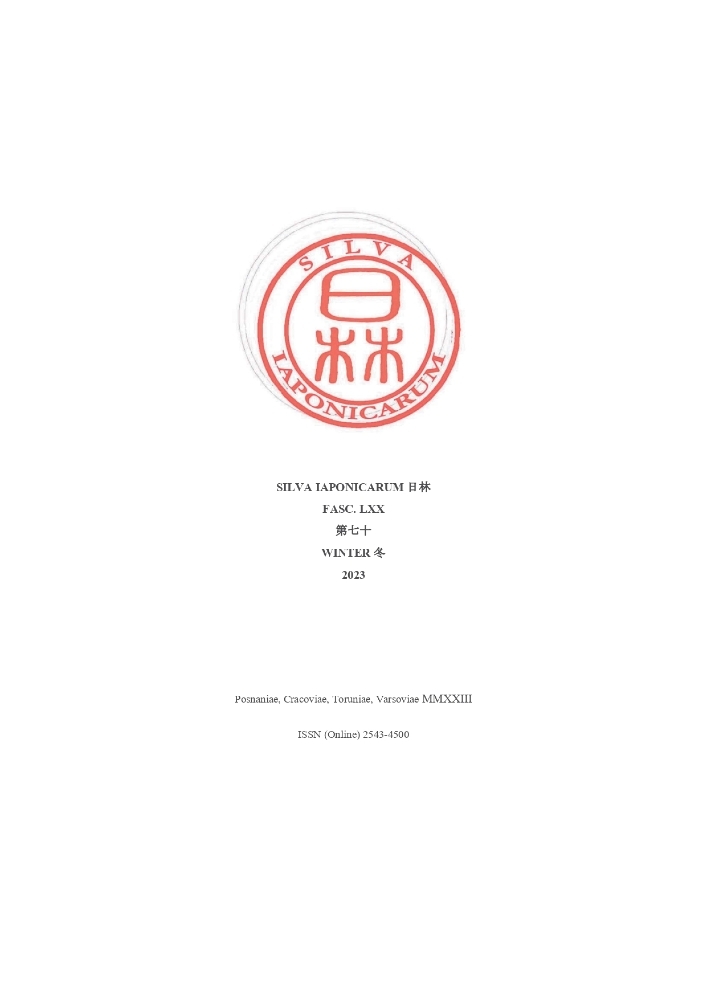Abstract
The translators have an ambiguous role in the process of a literary translation – they have to be as transparent as possible, though they must often interpret the text before translating it. In fact, they present their own dialogue with the author to the reader and thus, it is difficult for them to not influence a narrative with their presence (Venuti 1986: 182). Translators can, however, choose how and where they are visible. The purpose of this paper is to analyze the way a literary translator becomes visible to the reader through the translation. Three short stories – in first-person narrative – from the novel Hyperion by Dan Simmons and translated by Sakai Akinobu are discussed. The article focuses on the analysis of translator’s choices regarding vulgarisms and emotional load in a text generally, that influences the way the reader understands the text.
References
Bal, Mieke 2012 [2009]. Narratologia. Wprowadzenie do teorii narracji [narratology: introduction to the theory of narrative]. Translated by Ewa Kraskowska, Ewa Rajewska et al. Cracow: Wydawnictwo Uniwersytetu Jagiellońskiego.
Barthes, Roland 1975. “An introduction to the structural analysis of narrative”. New Literary History 6 (2): 237–272. DOI: https://doi.org/10.2307/468419
Bayley, Nicholas A. 2013. The expression of emotion in language and in translation: failures and successes in English translations. Speech script on BT2013. URL: https://www.researchgate.net/publication/324574188_The_Expression_of_Emotion_in_Language_and_in_Translation [access date: 20 February 2023].
Benjamin, Walter 1923. “The translator’s task”. Translated by Steven Rendall. In: Alexis Nouss (ed.) 1997. TTR: Traduction, Terminologie, Rédaction 10 (2). Quebec: McGill University. 151–165. DOI: https://doi.org/10.7202/037302ar
Booth, Wayne C. 1983. The rhetoric of fiction. Chicago: The University of Chicago. DOI: https://doi.org/10.7208/chicago/9780226065595.001.0001
Bun Setsu 2018. Yakuwarigo-no hon’yaku shuhō [yakuwarigo translation methodology]. Doctoral dissertation. Osaka: Osaka University文雪. 『役割語の翻訳手法』. 大阪大学博士論文.
Burzyńska, Anna 2008. Idee narracyjności w humanistyce [ideas of narrativity in the humanities]. In: Bernadetta Janusz, Katarzyna Gdowska, Bogdana de Barbaro (eds.). Narracja: teoria i praktyka [theory and practice of narration]. Cracow: Wydawnictwo Uniwersytetu Jagiellońskiego. 21–36.
Ewick, Patricia, Susan S. Silbey 1995. “Subversive stories and hegemonic tales: toward a sociology of narrative”. Law & Society Review 29 (2): 197– 226. DOI: https://doi.org/10.2307/3054010
Głowiński, Michał, Aleksandra Okopień-Sławińska, Janusz Sławiński 1986. Zarys teorii literatury [an outline of literary theory]. Warsaw: Wydawnictwa Szkolne i Pedagogiczne.
Goyet, Florence 2014. The classic short story, 1870–1925: theory of a genre. Cambridge: Open Book Publishers. DOI: https://doi.org/10.11647/OBP.0039
Grochowski, Maciej 1995. Słownik polskich przekleństw i wulgaryzmów [the dictionary of Polish swear words and vulgarisms]. Warsaw: Państwowe Wydawnictwo Naukowe.
Gruszczyńska, Ewa 2019. “Wulgaryzmy w dyskursie medialnym a przekład [vulgarisms in media discourse and translation]”. In: Ewa Gruszczyńska, Małgorzata Guławska-Gawkowska, Anna Szczęsny (eds.). Translatoryczne i dyskursywne oblicza komunikacji [translational and discursive aspects of communication]. Warszawa: Instytut Lingwistyki Stosowanej UW.
Hejwowski, Krzysztof 2004. Kognitywno-komunikacyjna teoria przekładu [cognitive-communicative theory of translation]. Warsaw: Państwowe Wydawnictwo Naukowe.
Hirata, Yumi 2010. “The narrative apparatus of modern literature: the shifting ‘standpoint’ of early Meiji writers”. Translated by Tess M. Orth. In: Michael K. Bourdaghs (ed.). The linguistic turn in contemporary Japanese literary studies: politics, language, textuality. Michigan: University of Michigan Press. 73–96.
Hjort, Minna 2017. “Affect, risk management and translation of swearing”. RASK – International Journal of Language and Communications 46: 159– 180.
Kinsui, Satoshi 2017. Virtual Japanese: enigmas of role language. Osaka: Osaka University Press.
Königsberg, Matthew 2008. “The ‘transparent narrator’ revisited: Ozaki Kōyō and genbun itchi”. Japanese Language and Literature 42 (1): 197– 226.
Kulas, Piotr 2014. “Narracja jako przedmiot badań oraz kategoria teoretyczna w naukach społecznych [narration as a research object and theoretical category in the social sciences]”. Kultura i Społeczeństwo 4: 111– 130.
Lamarque, Peter 2004. “On not expecting too much from narrative”. Mind & Language 19 (4): 393–408. DOI: https://doi.org/10.1111/j.0268-1064.2004.00265.x
Law, Molly 2022. “What is the meaning and significance of ‘Jesus Wept’?”. Christianity.com. URL: https://www.christianity.com/wiki/bible/significance-of-jesus-wept-in-the-face-of-death.html [access date: 14 May 2022].
Lee Haruki 2014. “Eigoteki-na hyōgen-to nihongoteki-na hyōgen / Englishness and Japaneseness”. Gaikokugo Gakubu Kiyō 10: 99–105.李春 喜. 「英語的な表現と日本語的な表現」. 『外国語学部紀要』.
Livni, Ephrat 2017. “The most offensive curse word in English has powerful feminist origins”. Quartz. URL: https://qz.com/1045607/the-most-offensive-curse-word-in-english-has-powerful-feminist-origins/ [access date: 4 March 2022].
May, Rachel 1994. “Where did the narrator go? Towards a grammar of translation”. The Slavic and East European Journal 38 (1): 33–46. DOI: https://doi.org/10.2307/308545
Melanowicz, Mikołaj 2012. Historia literatury japońskiej [the history of Japanese literature]. Warsaw: Państwowe Wydawnictwo Naukowe.
Nishio Junji 2003. Mainasu taigū hyōgen-no gengo kōdōteki kenkyū / Linguistic-behavioral study of negative attitude expression. Doctoral dissertation. Osaka: Osaka University. 西尾純ニ. 『マイナス待遇表現の言語行動論的研究』. 大阪大学博士論文.
Pekkanen, Hilkka 2013. “The translator’s voice in focalization”. In: Kristiina Taivalkoski-Shilov, Myriam Suchet (eds.). La traduction des voix intra-textuelles / Intratextual voices in translation. Montréal: Editions Québécoises de L’oeuvre.
Sadza, Agata 2013. “Narratologia Mieke Bal [Mieke Bal’s Narratology]”. Przekładaniec 27: 238–245.
Schnurer, Herman 1941. “On vulgarity”. The Antioch Review 1 (4): 499–510. DOI: https://doi.org/10.2307/4608856
Simmons, Dan 2005 [1989]. Hyperion. London: Gollancz.
[Simmons, Dan] Shimonzu, Dan 2000a. Haiperion (jō) [Hyperion part 1]. Translated by Sakai Akinobu. Tokyo: Hayakawa Shōbō. シモンズ・ダン.『ハイペリオン上』. 酒井昭伸訳. 東京都: 早川書房.
[Simmons, Dan] Shimonzu, Dan 2000b. Haiperion (ge) [Hyperion part 2]. Translated by Sakai Akinobu. Tokyo: Hayakawa Shōbō. シモンズ・ダン.『ハイペリオン下』. 酒井昭伸訳. 東京都: 早川書房.
Takubo Yukinori 1997. “Nihongo-no ninshō hyōgen / Personal expressions in Japanese”. In: Takubo Yukinori (ed.). Shiten-to gengo kōdo [perspective and linguistic behaviors]. Tokyo: Kuroshio Shuppan. 12–44. 田窪行則.「日本語の人称表現」. 田窪行則編『視点と言語行動』. 東京都:くろしお出版.
Venuti, Lawrence 1986. “The translator’s invisibility”. Criticism 28 (2): 179–212.
Verrett, Bethany 2022. “Why it’s so important that ‘Jesus wept’”. Bible Study Tools. URL: https://www.biblestudytools.com/bible-study/topical-studies/short-and-sweet-why-its-so-important-that-jesus-wept.html [access date: 14 March 2023].
Yoda, Tomiko 2006. “First-person narration and citizen-subject: The modernity of Ōgai’s The Dancing Girl”. The Journal of Asian Studies 65 (2): 277–306. DOI: https://doi.org/10.1017/S0021911806000660
License
Copyright (c) 2023 Aleksandra Przybysz

This work is licensed under a Creative Commons Attribution-NonCommercial 4.0 International License.


